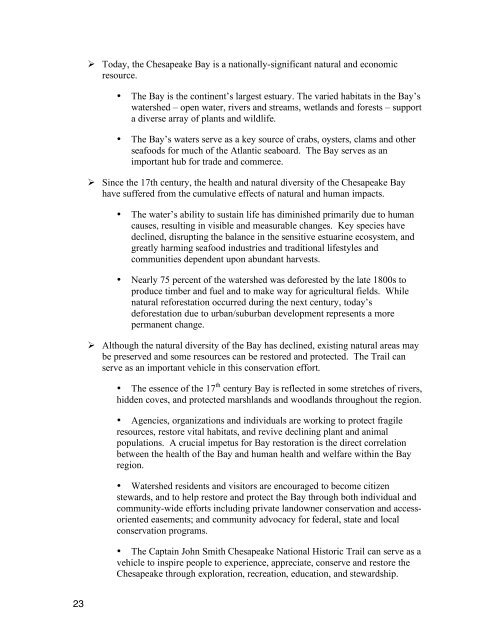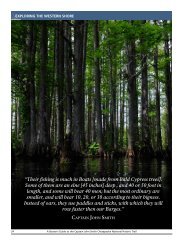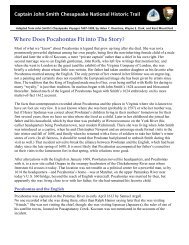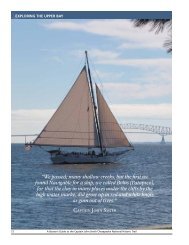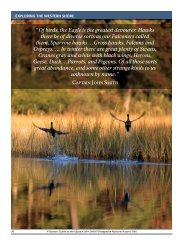Draft Interpretive Plan Join the adventure! - Captain John Smith ...
Draft Interpretive Plan Join the adventure! - Captain John Smith ...
Draft Interpretive Plan Join the adventure! - Captain John Smith ...
You also want an ePaper? Increase the reach of your titles
YUMPU automatically turns print PDFs into web optimized ePapers that Google loves.
Today, <strong>the</strong> Chesapeake Bay is a nationally-significant natural and economic<br />
resource.<br />
• The Bay is <strong>the</strong> continent’s largest estuary. The varied habitats in <strong>the</strong> Bay’s<br />
watershed – open water, rivers and streams, wetlands and forests – support<br />
a diverse array of plants and wildlife.<br />
• The Bay’s waters serve as a key source of crabs, oysters, clams and o<strong>the</strong>r<br />
seafoods for much of <strong>the</strong> Atlantic seaboard. The Bay serves as an<br />
important hub for trade and commerce.<br />
Since <strong>the</strong> 17th century, <strong>the</strong> health and natural diversity of <strong>the</strong> Chesapeake Bay<br />
have suffered from <strong>the</strong> cumulative effects of natural and human impacts.<br />
• The water’s ability to sustain life has diminished primarily due to human<br />
causes, resulting in visible and measurable changes. Key species have<br />
declined, disrupting <strong>the</strong> balance in <strong>the</strong> sensitive estuarine ecosystem, and<br />
greatly harming seafood industries and traditional lifestyles and<br />
communities dependent upon abundant harvests.<br />
• Nearly 75 percent of <strong>the</strong> watershed was deforested by <strong>the</strong> late 1800s to<br />
produce timber and fuel and to make way for agricultural fields. While<br />
natural reforestation occurred during <strong>the</strong> next century, today’s<br />
deforestation due to urban/suburban development represents a more<br />
permanent change.<br />
Although <strong>the</strong> natural diversity of <strong>the</strong> Bay has declined, existing natural areas may<br />
be preserved and some resources can be restored and protected. The Trail can<br />
serve as an important vehicle in this conservation effort.<br />
• The essence of <strong>the</strong> 17 th century Bay is reflected in some stretches of rivers,<br />
hidden coves, and protected marshlands and woodlands throughout <strong>the</strong> region.<br />
• Agencies, organizations and individuals are working to protect fragile<br />
resources, restore vital habitats, and revive declining plant and animal<br />
populations. A crucial impetus for Bay restoration is <strong>the</strong> direct correlation<br />
between <strong>the</strong> health of <strong>the</strong> Bay and human health and welfare within <strong>the</strong> Bay<br />
region.<br />
• Watershed residents and visitors are encouraged to become citizen<br />
stewards, and to help restore and protect <strong>the</strong> Bay through both individual and<br />
community-wide efforts including private landowner conservation and accessoriented<br />
easements; and community advocacy for federal, state and local<br />
conservation programs.<br />
• The <strong>Captain</strong> <strong>John</strong> <strong>Smith</strong> Chesapeake National Historic Trail can serve as a<br />
vehicle to inspire people to experience, appreciate, conserve and restore <strong>the</strong><br />
Chesapeake through exploration, recreation, education, and stewardship.<br />
23


